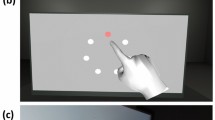Abstract
When interacting in a virtual environment, users are confronted with a number of interaction techniques. These interaction techniques may complement each other, but in some circumstances can be used interchangeably. Because of this situation, it is difficult for the user to determine which interaction technique to use. Furthermore, the use of multimodal feedback, such as haptics and sound, has proven beneficial for some, but not all, users. This complicates the development of such a virtual environment, as designers are not sure about the implications of the addition of interaction techniques and multimodal feedback. A promising approach for solving this problem lies in the use of adaptation and personalization. By incorporating knowledge of a user’s preferences and habits, the user interface should adapt to the current context of use. This could mean that only a subset of all possible interaction techniques is presented to the user. Alternatively, the interaction techniques themselves could be adapted, e.g. by changing the sensitivity or the nature of the feedback. In this paper, we propose a conceptual framework for realizing adaptive personalized interaction in virtual environments. We also discuss how to establish, verify and apply a user model, which forms the first and important step in implementing the proposed conceptual framework. This study results in general and individual user models, which are then verified to benefit users interacting in virtual environments. Furthermore, we conduct an investigation to examine how users react to a specific type of adaptation in virtual environments (i.e. switching between interaction techniques). When an adaptation is integrated in a virtual environment, users positively respond to this adaptation as their performance significantly improve and their level of frustration decrease.









Similar content being viewed by others
References
Bowman DA, Kruijff E, LaViola JJ, Poupyrev I (2005) 3D user interfaces, theory and practice. Addison-Wesley
Bowman DA, Chen J, Wingrave CA, Lucas J, Ray A, Polys NF, Li Q, Haciahmetoglu Y, Kim J-S, Kim S, Boehringer R, Ni T (2006) New directions in 3d user interfaces. Int J Virtual Real 5(2):3–14
Celentano A, Nodari M, Pittarello F (2004) Adaptive interaction in web3d virtual worlds. In: Proceedings of the 9th 3D web, pp 41–50
Chin DN (2001) Empirical evaluation of user models and user-adapted systems. User Model User-Adapt Interact 11(1–2):181–194
Debevc M, Meyer B, Donlagic D, Svecko R (1996) Design and evaluation of an adaptive icon toolbar. User Model User-Adapt Interact 6(1):1–21
Gajos KZ (2008) Automatically generating personalized user interfaces. PhD thesis, University of Washington
Greenberg S, Witten IH (1985) Adaptive personalized interfaces: a question of viability. Behav Inf Technol 4(1):31–45
Hazlett R (2003) Measurement of user frustration: a biologic approach. In: CHI ’03: CHI ’03 extended abstracts on human factors in computing systems. ACM, New York, NY, USA, pp 734–735
Jameson A, Wittig F (2001) Leveraging data about users in general in the learning of individual user models. In: Proceedings of the 17th IJCAI
Kobsa A (1993) User modeling: recent work, prospects and hazards. In: Schneider-Hufschmidt M, Malinowski U, Kuhme T (eds) Adaptive user interfaces: principles and practice. Elsevier Science Inc., pp 111–128
Lavie T, Meyer J (2010) Benefits and costs of adaptive user interfaces. Int J Hum-Comput Stud. doi:10.1016/j.ijhcs.2010.01.004
Mandryk RL, Inkpen KM, Calvert TW (2006) Using psychophysiological techniques to measure user experience with entertainment technologies. Behav Inform Technol 25(2):141–158
Novak D, Mihelj M, Munih M (2009) Using psychophysiological measurements in physically demanding virtual environments. In: INTERACT (1), pp 490–493
Octavia JR, Raymaekers C, Coninx K (2009) Investigating the possibility of adaptation and personalization in virtual environments. In: Houben GJ, McCalla G, Pianesi F, Zancanaro M (eds) UMAP 2009. LNCS, vol 5535. Springer, pp 361–366
Poupyrev I, Billinghurst M, Weghorst S, Ichikawa T (1996) The go-go interaction technique: non-linear mapping for direct manipulation in vr. In: UIST ’96: Proceedings of the 9th annual ACM symposium on user interface software and technology. ACM, New York, NY, USA, pp 79–80
Poupyrev I, Weghorst S, Billinghurst M, Ichikawa T (1998) Egocentric object manipulation in virtual environments: evaluation of interaction techniques. Comput Graph Forum 17(3):41–52
Rocchi C, Graziola I, Goren-Bar D, Stock O, Zancanaro M (2007) Adaptive multimedia guide. In: PEACH: intelligent interfaces for museum visits. Springer, New York, pp 3–22
Vanacken L, Cuppens E, Clerckx T, Coninx K (2007) Extending a dialog model with contextual knowledge. In: TAMODIA 2007. LNCS, vol 4849. Springer, pp 28–41
VanackenL, De Boeck J, Raymaekers C, Coninx K (2008) Designing context-aware multimodal virtual environments. In: ICMI 2008. Chania, Crete, Greece, pp 129–136
Vanacken L, Grossman T, Coninx K (2009) Multimodal selection techniques for dense and occluded 3d virtual environments. Int J Hum-Comput Stud 67(3):237–255
Wingrave CA, Bowman DA, Ramakrishnan N (2002) Towards preferences in virtual environment interfaces. In: Proceedings of the 8th EGVE, pp 63–72
Acknowledgements
The authors would like to thank Lode Vanacken for his assistance in the implementation work for the experiment. We also thank the participants for their valuable contributions in the experiment.
Author information
Authors and Affiliations
Corresponding author
Rights and permissions
About this article
Cite this article
Octavia, J.R., Raymaekers, C. & Coninx, K. Adaptation in virtual environments: conceptual framework and user models. Multimed Tools Appl 54, 121–142 (2011). https://doi.org/10.1007/s11042-010-0525-z
Published:
Issue Date:
DOI: https://doi.org/10.1007/s11042-010-0525-z




